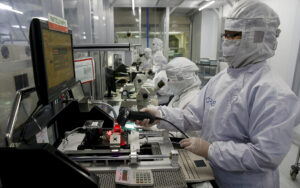Less talk about inflation

Headline inflation in June surged by 6.1% year on year from 5.4% in May and 3.7% a year ago, the Philippine Statistics Authority (PSA) reported. This was slightly higher than the 6% median estimate in a BusinessWorld poll conducted at end June, but within the 5.7%-6.5% forecast range of the Bangko Sentral ng Pilipinas (BSP) for the month (BusinessWorld, July 5, 2022).
June’s inflation rate matched the pace recorded in November 2018 and was the fastest growth since the 6.9% print in October 2018. It was the third consecutive month that inflation went above the BSP’s 2-4% target range.
“6.1? I think I will have to disagree with that number. We are not that high,” President Ferdinand “Bongbong” Marcos, Jr. said at a press briefing following his first Cabinet meeting in Malacañang (GMA News, July 5, 2022).
National Statistician and PSA chief Dennis Mapa retorted, “The Philippine Statistics Authority stands by its report” (Ibid.). Finance Secretary Benjamin Diokno quickly defended Mr. Marcos Jr. saying, “The President’s disbelief at the 6.1% June 2022 inflation rate figure was misunderstood. He was referring to it as a full-year figure when in fact, the year-to-date, meaning January to June average inflation rate is actually 4.4%.” (Rappler, July 6, 2022).
At the press conference, Neil Mercado of Inquirer asked Mr. Marcos Jr.: “Inflation rate soared to 6.1%, the highest since October 2018. Does the President have any concrete plan to address this? Paano matutulungan ang mga Pilipinong umaaray na sa taas ng presyo ng bilihin (How will you help Filipinos feeling the pinch of high prices of goods)?” (Ibid.).
The question stumped the new president. It is indeed difficult to feel around the edges of inflation — what is the extent of the spillage, and how to sop it up with the proper remedies. Maybe not even the most technically adept statisticians or astute econometrists can accurately measure and conclude on the interplay of macroeconomic supply and demand that would raise prices and affect gross national product, much less anticipate the most micro elasticities in each economic participant’s deepest heart to determine the personal effect of changes in purchasing power and value of money. Inflation is felt, before it is known.
“In June, the World Bank projected in its Global Economic Prospects that the inflation rate in advanced economies rose from 1.9% to 6.95% in the year to April, while the inflation rate in the emerging and developing economies increased from 4.23% to 9.37% over the same period. The high inflation rate is expected to be persistent rather than transitory, as Russia’s invasion of Ukraine has further increased food and energy prices, hitting net food and/or energy importers particularly hard” (thediplomat.com June 20, 2022).
“Our inflation is imported,” Mr. Marcos Jr. said (on GMA News, cited), albeit ambiguously, maybe for lack of scientific nomenclature to define our economic situation as a “supply-side” problem that has caused rising “cost-push” inflation. Less talk na lang sana, but, yes, we must talk about “the elephant in the room” and try to feel around its size and might, in the complicating, persisting COVID-19 pandemic that has breast-fed the global inflation pandemic.
Perhaps former Secretary Ernesto Pernia talked too much, in his time as National Economic and Development Authority (NEDA) chief for four years in President Rodrigo Duterte’s term. In a statement, Mr. Pernia said he chose to leave his post due to personal reasons as well as “differences in development philosophy with a few of my fellow Cabinet members” (CNN Philippines, April 17, 2020). “Monetary policy is more of a demand side solution to inflation, not the supply side. But our inflation is mostly caused by the supply side — the availability of goods, high global oil prices. Those are the main causes of supply side inflation, as well as the unavailability of rice on time,” Mr. Pernia said. (Rappler, Aug. 10, 2020).
The US Federal Reserve increased its benchmark interest rate by 75 basis points to a range of 1.5%-1.75% in June — the biggest increase since 1994. Fed Chair Jerome Powell flagged that there could be another rate hike in July. The Reserve Bank of Australia is set to raise rates again on Tuesday, and other Asia-Pacific economies like the Philippines, Singapore, and Malaysia have all jumped on the same rate hike bandwagon (cnbc.com July 4, 2022). Effective June 24, 2022, the BSP/Monetary Board raised the interest rate on the BSP’s overnight reverse repurchase facility by 25 basis points to 2.5% (100 basis points equal 1%). Accordingly, the interest rates on the overnight deposit and lending facilities were raised to 2% and 3%, respectively (bsp.gov.ph).
Perhaps monetary policy is the wrong solution to inflation, many analysts now say, and as Mr. Pernia stressed in his time. Raising interest rates in inflation discourages borrowers, who would not lock in on high rates for long periods. It alarms lenders and investors (especially the individual investors), who calculate the real interest rate to be net of the inflation rate, finding little remaining value, or, worse, a “negative carry” (inflation rate is higher than the nominal interest rate), all for the risk of lending. Then also, borrowers at high interest rates, in high inflation, would clearly be desperate borrowers, and considered high-risk. Risk is so heightened in inflation, such that those with the excess cash would rather hoard scarce goods and buy real assets (going cheaper because of the need of some for liquidity amidst depreciating local currency).
HSBC senior economic advisor Stephen King said that “it is not simply either demand or supply shock that is to blame for inflation, but the workings of both sides of the equation. Both pandemic lockdowns, supply chain upheavals and the Russia-Ukraine war, as well as the stimuli governments pumped into their economies and loose monetary policies, have contributed to rising inflation” (cnbc.com, July 4, 2022).
“Authorities have to use all available policy tools to address inflation, including monetary measures to prevent the de-anchoring of inflation expectations, and supply-side measures such as importation and lower tariffs and non-tariff barriers for important commodities to help augment domestic supplies as needed, and greater support to agriculture production through extension services, seeds, and fertilizer,” said Karl Chua, then NEDA Chief in the Duterte administration. (Rappler, May 25, 2022).
Postpone income tax cuts, slap new taxes, slash VAT exemptions, outgoing Finance Secretary Carlos Dominguez III said at his exit press conference on May 25, where he presented his proposed transition plan to the then-assumptive political governance. (Read my column, “The proposed fiscal consolidation and resource mobilization plan,” in BusinessWorld on June 5.)
The pragmatist might realize some weaknesses heightened in this inflation, of “supply-side economics” upon which the aggressive Build, Build, Build strategic plan and the fiscal policy under the Tax Reform for Acceleration and Inclusion (TRAIN) law were based. There seems to be no formal reaction yet by the new Finance department, now led by Benjamin Diokno (BSP Governor under Duterte) to Dominguez’ proposed fiscal consolidation plan, nor has a counter-plan, or a totally new plan been made transparent to the people.
There should be less talk about inflation and seeming denial about the sorry state of the Philippine economy. An economic plan of action must be transparent so that it will ease the apprehensions of the people about what darker doom might be approaching while the COVID gloom wouldn’t yet let go.
Amelia H. C. Ylagan is a doctor of Business Administration from the University of the Philippines.




